 Your Mission…
Your Mission…
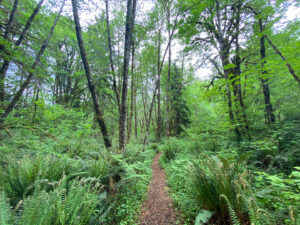
Locate and photograph evidence of woodpeckers!
Darlin Creek Preserve is a 312-acre nature preserve that is conserved by Capitol Land Trust (CLT). When land is conserved it means it is protected. The wetlands, streams, plants and animals are all protected, keeping the land in as natural a state as possible so that plants and animals will thrive here forever.
Capitol Land Trust conserved this property because of its important freshwater wetland and forest habitat used by many birds, fish, amphibians, mammals and other wildlife.
The trails meander through a forest mixed with deciduous trees, like the bigleaf maples that drop their large yellow leaves each fall, and coniferous trees, like Western red cedar, who keep their lacy evergreen leaves during the winter. Along the trails you’ll see beaver dams, walk through a forest being replanted and travel across the Darlin Creek bridge.
Darlin Creek Preserve is one of over 80 properties Capitol Land Trust conserves for their benefits to wildlife, water quality, and people. Four of these preserves are managed for public access with trails, signs, and benches for people to visit and enjoy.
KNOW BEFORE YOU GO
- This trail is free to visit (no permit required).
- Open dawn to dusk.
- Dogs are allowed but must be kept on a leash. Please pick up after your pet and dispose of properly.
- No hunting or fishing, boat launching, fires/fireworks, camping, or motorized vehicles.
- No removal of vegetation or mushrooms.
- Stay on designated trails.
- There is a portable toilet with hand sanitizer near the trailhead.
- There is space for 11 cars at the trailhead.
- The trails are a mixture between dirt, gravel, and old roadbed at varying elevations.
- Please drive slowly through the neighborhood!
 Welcome to Darlin Creek Preserve
Welcome to Darlin Creek Preserve
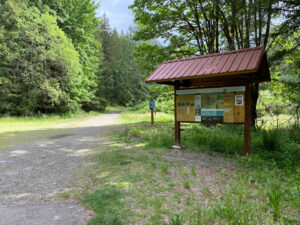
Stop by the kiosk south of the parking lot to see a trail map with information about the preserve and Capitol Land Trust.
Use the map to figure out which watershed Darlin Creek Preserve is a part of. A watershed is an area of land where the water drains to a central point. A watershed is made up of streams and rivers that drain into a single larger water body like a larger river, Puget Sound or the ocean.
Hint: This watershed is the second largest watershed in Washington State!
This walking journey will take you around the Wetland Forest Loop Trail (the yellow trail on the trail map), then continue straight (south) along the Wetland Forest Loop Trail.
 Environmental Restoration
Environmental Restoration
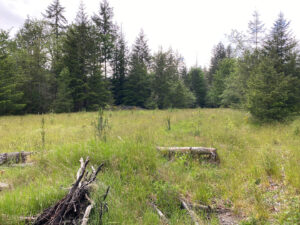
Can you find the open area with newly planted trees? In 2018, this entire area was covered in a non-native invasive plant species called Scotch broom (Cytisus scoparius).
Invasive species can be both plants and animals and are introduced meaning they have been brought from another region or part of the world by humans and planted in an area where they do not naturally grow.
Why are invasive species a concern?
Invading non-native species change the native habitat used by wildlife. They are hard to control and compete with local native plants taking over entire areas. Some are harmful to wildlife and humans.
Learn more about invasive species in Western Washington.
Learn more about weed identification, species fact sheets, and control of noxious or invasive weeds, including Scotch broom.
Since 2018, volunteers have planted and helped maintain native plants in this area.
See if you can name the native plants used in the restoration project!
 It’s the Water
It’s the Water
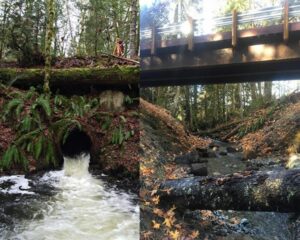
Here’s an old riddle, can you solve it?
What runs but never walks, has a mouth but cannot talk, has a head but doesn’t think and has a bed but does not sleep? What is it? A stream!
Can you hear it? It’s Darlin Creek!
Fish passage restoration:
Tens of thousands of miles of roads and highways cross over rivers and streams. Each of these road crossings uses a human made structure so that we can drive over these water ways. Many large rivers use bridges, but the smaller rivers, streams and creeks use pipes called culverts to direct water under roadways. Numerous culverts have been found to sit above the stream bed preventing fish such as salmon from swimming upstream, blocking their upstream migration.
Since 2005 over 3000 miles of stream habitat have been opened to migrating salmon in Washington State. Restoring fish passage is a very important piece of the puzzle in bringing back and increasing salmon populations. Much work and millions of dollars are spent each year replacing culverts as seen in this video https://www.youtube.com/watch?v=u7HT6oMqAco.
If you walk down to the bridge, you can see Darlin Creek. In 2016 the old culvert was removed and replaced with a bridge. The old culvert was sitting above the stream, perched creating a barrier to salmon migration. The attached photo shows before and after pictures of the stream crossing. Can you see the difference in how salmon can now swim further up the stream? Can you answer the quiz from the sign?
Just past the bridge, take the narrow trail to the right.
 Freshwater Wetlands
Freshwater Wetlands
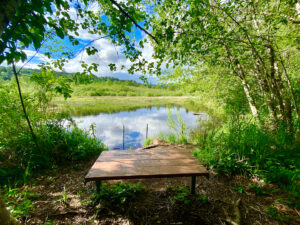
Can you find the bench overlooking the wetland? What do you see? Is the water high or low?
Freshwater wetlands are areas that hold water for all or part of the year. Water levels change from low to high and back again throughout the seasons depending on the amount of rain fall.
Wetlands provide homes for many birds, insects, fish and wildlife.
What wildlife do you see using the wetland? Here are a few species that may be seen in freshwater wetlands in Western Washington.
Do you know why freshwater wetlands are important?
Here are a few facts!
Wetlands:
- Improve water quality and remove pollutants through biological process
- Store and slowly release flood waters
- Provide clean water and recharge or refill groundwater storage called aquifers that provide water for streams to flow
- Provide homes and habitat for many fish and wildlife
- Help with climate change as they capture and store carbon
Learn more about the many benefits of freshwater wetlands.
 Beavers!
Beavers!
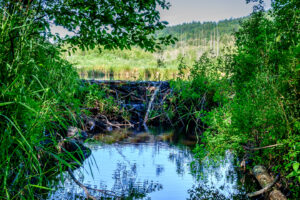
Darlin Creek Preserve is covered in wetland ponds created and maintained by beavers. See if you can sleuth out evidence of beaver such as a beaver dam or beaver chewed trees along the way!
To the right of the bench, water can be seen flowing into Darlin Creek, where for years, beavers have maintained a dam. During the December 2021 storms, high water levels washed out the beaver dam. Do you think the beavers will rebuild their dam? Most likely they already have!
Check out this cool 10-minute video from the wildlife camera on the beaver dam over the past at CLT’s Kids preserve.
Did you know? A beaver’s teeth never stop growing so that they always have sharp, fresh teeth to gnaw on tough wood!
 Who Lives Here?
Who Lives Here?
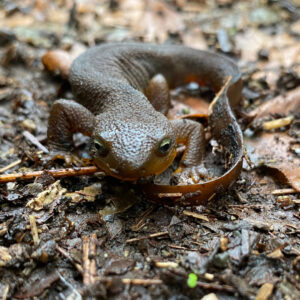
Many animals such as birds, insects, reptiles, amphibians, small and large mammals use the preserve for all or part of their life stages.
Have you found any clues to which animals live here?
Can you name the three essentials for wildlife?
All animals need:
- Food
- Water
- Shelter or cover
Watch for rough skinned newts along the trail as they migrate to the pond in spring for breeding and back to the forest in fall. Keep an eye out for this dark brown salamander with its bright underbelly that notifies potential predators that it is poisonous to eat. Like many of our amphibian their great camouflage helps them blend in. Try walking like one!
Another animal likely to live nearby is the skunk. You are not likely to see skunks as they are mostly nocturnal, sleeping during the day in a rotted log or burrow and eating at night. Skunks are omnivorous eating both meat and plants.
Washington is home to two skunks including the striped and the spotted skunk. They are easy to recognize with their bold black and white coloration and their distinctive musky smell.
 Woodpeckers of Western Washington
Woodpeckers of Western Washington
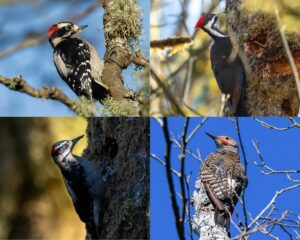
Woodpeckers are amazing birds! Their spongey skulls act as shock absorbers as they peck through wood searching for food.
Did you know? In Washington there are 11 species of woodpeckers, five of these species live in Western Washington. See if you can detect all five species!
Have you seen evidence of woodpeckers? Hint: look for dead or dying standing trees with holes.
These trees are called snags, and they are an essential habitat for cavity nesting birds, like woodpeckers and other wildlife. They provide an important food source, as the wood decays, insects gather. Woodpeckers use their strong beaks to peck holes in the wood searching for bugs to eat. Their holes can often be seen on snags and come in different shapes and sizes.
Pileated woodpeckers are known for their large, rectangular holes in snags. Learning about woodpeckers can help you tell which species might have made the holes you see.
Learn more about woodpecker habits.
Remember to snap a photo to complete your mission!
 Native Plants
Native Plants
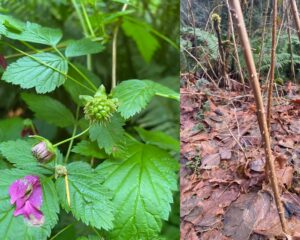
As you go, see if you can identify a few of our beautiful native plant species. Salmonberry is a bird and pollinator magnet because of its early magenta flowers and tasty salmon orange colored berries. It grows best in wet forested areas, along streams, rivers and forested wetlands. In the winter, salmonberry can be identified by its light brown and lightly armored bark.
Note about foraging or eating along the way: Darlin Creek Preserve is a protected area and home for many birds and wildlife. Please leave the berries and other edibles such as mushrooms for the birds and wildlife to eat!
There is a history of past logging of this area. Can you find a bigleaf maple that has begun to re-sprout after being cut down? Bigleaf maples are named for their giant leaves which provide nutrients to the forest floor when they fall. Their thick layer of fallen leaves provide homes for many small animals such as Northwestern salamander. These shy salamanders differ from the rough skinned newt as its skin is glossy and smooth, and its belly is brown same as its back. Have you seen any?
Did you know? Bigleaf maples have the most abundant epiphyte (plants that grow on other plants) load of any tree in the Pacific Northwest? See if you can locate one of the common epiphytes growing on the bigleaf maple limbs, the licorice fern.
 Nurse Logs and Stumps
Nurse Logs and Stumps
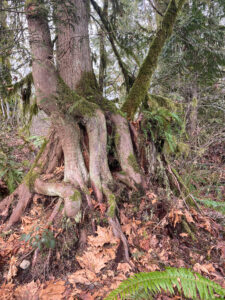
As the trail descends towards Lake Lucinda, hunt for nurse stumps and logs along the trail. Nurse logs are fallen trees and nurse stumps are broken or cut trees where only the stump, usually Western red cedar is left. As they decay, these logs and stumps provide many nutrients to the forest floor, and a rich nursery for new seedling trees and other vegetation to grow.
Can you identify any plants or trees growing from the nurse stump?
Western hemlock and red huckleberry can often be found growing from nurse logs or stumps.
 Signs of Woodpeckers: Red-breasted Sapsucker
Signs of Woodpeckers: Red-breasted Sapsucker
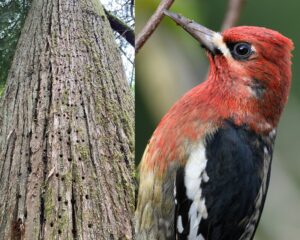
Just before the trail reaches Lake Lucinda, can you locate a Western red cedar with neat, straight rows of holes drilled into its bark? Who made these?
 Congratulations!
Congratulations!
You have completed your mission to locate and photograph evidence of woodpeckers! Don’t forget to login to the Goose Chase App and submit your photo for this mission to collect your park specific sticker!
